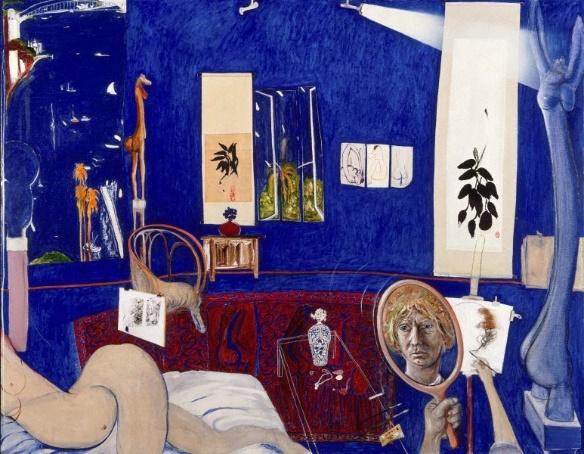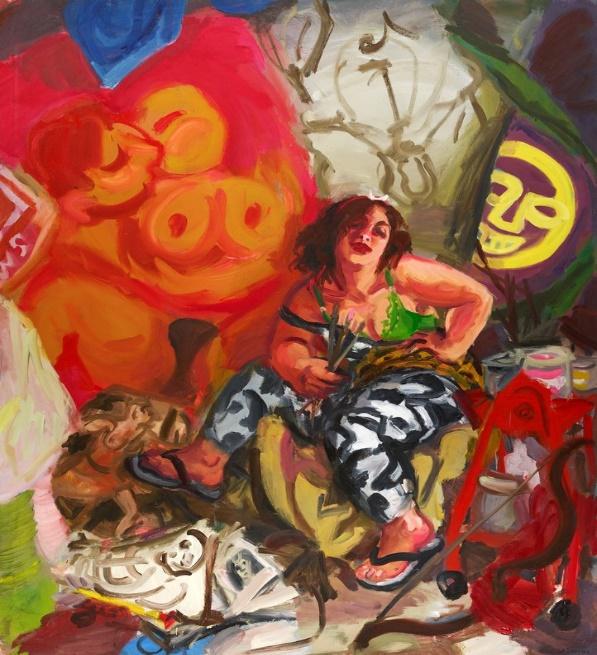Works of art’s analysis is an essential factor in visualizing the main aspects of the work. It includes containing the underlying meaning of a particular piece. In this case, the analysis of pictures consists of the description of such aspects as the three content areas. It includes the Frames, the relationships within the Conceptual Framework, and highlights of practice. Frames imply an analysis of work through the prism of four perspectives, namely subjective, structural, cultural, and postmodern aspects. The conceptual framework involves considering the art taking into account the artist itself, the audience, the artwork, and the world. Finally, the highlights of practice involve analysis of the work itself, namely which practices were applied to create the painting. Thereby, the purpose of the work is to consider three self-portraits from the perspective of three content areas.
The first chosen work is Self-portrait in the studio by Brett Whiteley, made in 1976. Whiteley is an Australian graphic artist, one of the main representatives of the lyrical direction in abstract expressionism (Jackson, 2019). After graduating from college, the artist studied painting at the Julian Ashton Art School. This period left a significant impression on Whiteley and influenced his future career as an artist. In addition, the painter also made a long trip to Italy, where one studied the works of famous authors. In the 1960s, one achieved international recognition after the publication of some works. Having received acknowledgment from the audience, Whiteley continues to develop in the chosen field. It formulates the conceptual framework of the selected work and the other ones, namely the impact of the world, the audience, and the artist’s life.
Talking about the subjective perspective of the work, one may conclude that the author highlights the effect of the particular color. Namely, the ultramarine blue color, which has an ecstasy-like effect (Bosco & Jordan, 2018). Structural perspective includes the meaning of the objects in the picture and what function they perform. For example, the mirror and Whiteley’s small self-portrait in the reflection signify the author’s influences from Oriental art. Thus, with the help of the structural aspect, the author conveys the importance of Oriental art for the artist. Moreover, it also depicts the cultural aspect of this work, namely the representation of the influence of oriental art. The postmodern factor is formulated by the psychological fraction of the painting, namely the attempt to escape from the author’s own psychology.
The practices which were applied to create the work include oil, collage, and hair on canvas. The size of the painting is 200.5 x 259.0 cm stretcher; 210.5 x 268.5 x 5.7 cm frame. It is worth noting that the work was created in different locations, which also had an impact on the pace of execution and the mood of the artist. Locations included Lavender Bay, Sydney, New South Wales, and Australia, the Whiteley’s homeland. The painting has wide popularity among the public and was shown at 21 exhibitions.
The second chosen work is Self-portrait as Diana of Erskineville by Wendy Sharpe. The artist was born in 1960 in Sydney and lived not only in the hometown but also in Paris. An only child in the family, Sharpe is of Russian and Jewish descent. The painter was influenced by the works of several famous artists, such as Max Beckmann and Chaim Soutine. The artist’s father, Alan Sharp, is a renowned writer and historian. In 1999-2000, Sharpe was commissioned by the Australian War Memorial and became the official Australian war artist. Moreover, the painter became the first woman after the Second World War to be rewarded with such a memorial. It is worth noting that Sharpe is the winner of many awards, such as the Sulman Prize, The Adelaide Perry Drawing Prize, the Portia Geach Memorial Prize, and the Archibald Prize.
All of these, along with the audience, which demonstrates recognition of the painter and the environment, articulated the conceptual framework. Namely, how it influenced the chosen field by the author. The subjective aspect is formulated by the method of conveying the main idea of the painting, given that the author has stated that one is not a portrait painter. However, there are autobiographical elements in the picture, which gives an additional subtext. Besides, it promotes considering the painting from different perspectives, such as from internal and external aspects. Structural and cultural factors are articulated by the presence of mythology in work, namely the reference to the Roman goddess Diana. Finally, the postmodern aspect is formed by the author’s goal to convey oneself through a mythological image, complementing the picture with another perspective and a field for reflection.
The practices of the work imply the creation by oil on canvas. The painting’s size is 210 x 172 cm, and it is worth noting that this is an attempt to convey a complete image of an individual character. The stance depicted in the portrait, namely the stoop, articulates the Australian sense of informality or indulgence. It has a sultry expression, and the outfit includes pants with an animal print and a green bra. A bright range of colors radiates energy and variety.
The last painting chosen for analysis is a Self-portrait, the executioner by Ben Quilty. The artist was born in the 1973 year in Australia and is a renowned artist and columnist. The painter has been awarded a number of awards in the painting, including the 2011 Archibald Prize, the 2014 Prudential Eye Award, and the 2009 Doug Moran National Portrait Prize (Witcomb & Message, 2020). The conceptual framework is formulated by the influence of some events and periods in the artist’s life. It includes periods of alcohol and drug use, in addition, the experience of a military artist and political activity in the youth also had a significant impact.
The cultural aspect of the work is articulated by the background for the creation of this work, namely the protest against the shooting of Australian drug smugglers. Quilty advocated pardoning smugglers, established friendly relations, and taught drawing one of them. It was the reason for the protest mood both in the author’s soul and as a way to convey this idea through the picture. The subjective aspect involves the transfer by the author of the consequences of the choice that everyone faces, namely to protest or give up. The structural factor includes the method of using paint and the distorted facial features, indicating the grief that the author experienced over the death of prisoners. In addition, the postmodern factor includes the author’s emotional experiences, protest moods, and consequences for people involved in certain events.
The practices to create the work are formulated by the usage of oil on linen. The painting’s size is 195.0 x 140.4 x 5.0 cm stretcher, and the date of creation is 2015. In conclusion, it is worth noting that many Australians share the opinion that smugglers should be pardoned. It was justified by repentance, a significant contribution to prison life, and the fact that they could do a lot of good for society. Bright colors in the center and gray ones around may symbolize the contrast between bright emotional experiences and the dullness of the walls of a prison cell. In a broader sense, it represents emotional experiences against the backdrop of the irreversible consequences of certain events.



References
Bosco, R., & Jordan, D. (2018). Defining the fringe of contemporary Australian archaeology: Pyramidiots, paranoia and the paranormal. Cambridge Scholars Publishing.
Jackson, P. (2019). Females in the frame: Women, art, and crime. Springer.
Witcomb, A., & Message, K. (2020). Museum theory. John Wiley & Sons.